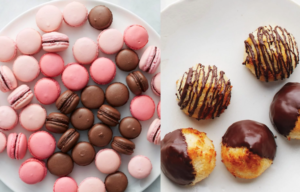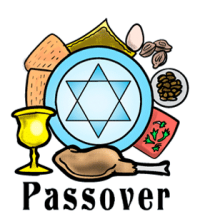What’s the Difference Between Macaroons and Macarons?
Martha Stewart Living
Their names are almost the same and they’re often confused but these gluten-free cookies each have a distinct look and taste
What a difference an “O” makes. There’s bound to be confusion when there are two cookies with such similar names, but the truth is macarons (pronounced “mack-ah-ROHN”) and macaroons (pronounced “mack-ah-ROON”) couldn’t be more distinctive looking and tasting. However, they do share one vital ingredient: whipped egg whites. What’s more, neither contains flour, making both treats gluten-free. For those reasons, it’s likely that they have a similar origin, although they each branched off at a certain point. Best of all, both macarons and macaroons are kosher for Passover because neither contain flour or leavening agents, which are forbidden to be eaten by anyone celebrating the eight-day holiday.
Here we’ll take you through the differences, from ingredients to technique to origin story.
Macarons
Macarons, which are confusingly sometimes called French macaroons, are delicate meringue and almond-flour based sandwich cookies with buttercream, jam, or ganache filling that comes in a variety of flavors. Modern-day macarons are typically associated with France, but versions of them are said to have been enjoyed in Europe all the way back to the Middle Ages. As it turns out, it’s actually the Italians who we may have to thank for the original cookies. In medieval times, there was a crunchy-on-the-outside, chewy-on-the-inside cookie made from almonds, egg whites, and sugar produced in Italian monasteries. It’s thought that Catherine di Medici brought them over to France in the 1500s and the French macaron was derived from the Italian maccherone.
While their origin story might be a little fuzzy, what’s undoubted is the fact that the French were instrumental in the macaron’s popularization. The first known written macaron recipe dates back to 17th century France. Famously, two nuns in the city of Nancy became known as the Macaron Sisters in 1792 after they survived the French Revolution by baking and selling the cookies, but their version still did not contain filling. Today, there’s a museum in Nancy dedicated to the macaron and the two nuns. It’s Paris that gets the glory for the modern iteration of two meringue-style cookies sandwiching a creamy flavored filling. According to the Ladurée, the famed French baker and sweets maker which was founded in 1862 and is still known for making some of the best macarons in the world, Pierre Desfontaines, grandson of Ladurée’s founder, was the first to take two macaron shells and fill them with a ganache, thus inventing the modern-day macaron known and loved around the world.
To make a French-style macaron, egg whites are whisked to make a stiff-peaked meringue. Then, flavorings, almond flour, and powdered sugar are carefully folded in to reduce air bubbles. The batter is then piped into flat, round circles to form the outer halves of the sandwich, with air bubbles being eliminated as much as possible. Uniformity is key here, and the texture after baking should be light and airy, with a delicate crunch on the outer shell. Buttercream, ganache, or jam fillings come in flavors as classic as vanilla, chocolate, and raspberry and as inventive as lavender, pumpkin, and coffee. The sky is the limit with flavoring and colors, making French macarons displays look like a delicate rainbow of identically shaped sandwich cookies, which appear almost like jewels.

Macaroons
Coconut-based macaroons are naturally gluten-free and contain a base of whipped egg whites, just like macarons. They probably have the same origins as French macarons do: medieval Italy. As noted above, Italian monasteries used to make cookies out of almonds, egg whites, and sugar around the eighth and ninth centuries. From there, it’s likely the cookie was adopted as a popular Passover treat by Jewish families from Italy because it has no flour or leavening, which are forbidden during the holiday. The exact time when this would have occurred is unclear, but soon enough the tradition spread throughout Europe and nut-based macaroons became a popular Passover dessert. Some Sephardic Jews still eat nut-based macaroons on Passover.
So, where did the coconut come from? In the 1890s, two companies (one in France and one in Philadelphia) invented shredded coconut in order to preserve the fruit for longer and prevent spoilage during shipments. This discovery provided bakers the ability to incorporate coconut into various sweets and candies, and it soon became a popular ingredient in desserts. It’s thought that the almond paste in macaroons was replaced with coconut to make the cookie less prone to spoilage, less fragile, and easier to transport. By the mid-1950s, Jewish food companies like Manischewitz and Streit’s had started manufacturing kosher for Passover items, including tins of coconut macaroons.
While many Jewish families in the United States may have memories of eating hard, dry, and generally not-so-tasty tinned macaroons during Passover, the category has experienced some innovation in the last decade, with unique flavors like salted caramel, as well as better ingredients and techniques that allow for moist and delicious cookies. And, of course, anything homemade is bound to taste better than what’s mass produced. These upgrades have made macaroons tasty enough to be eaten year round by many.
To make coconut-based macaroons, egg whites are whisked to create a stiff peaks. Then, shredded coconut, sugar, and any other flavorings are added before shaping into small balls or pyramids and baking. Macaroons are easier to make than macarons because their technique is simple and their imperfect, textured look is part of their allure
